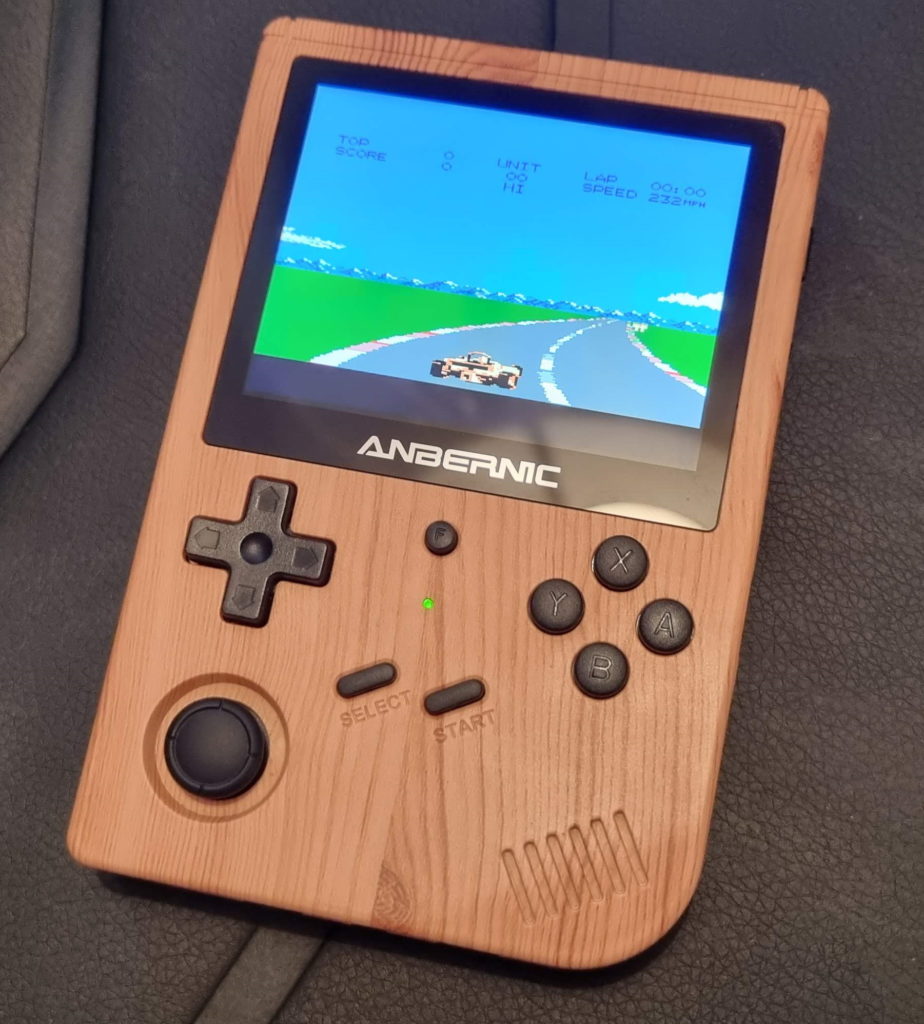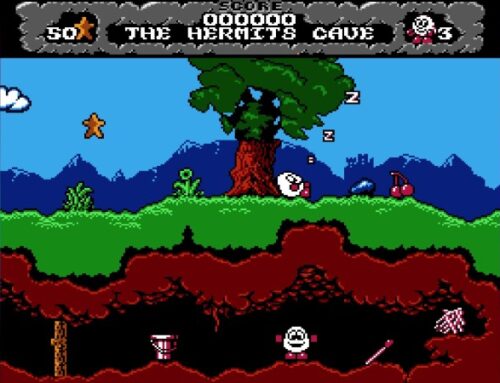
We’re not all grizzled retro gaming veterans — some of us are new to the hobby. So our Getting Into Retro Gaming guides are here to help you get up and running as soon as possible! If there’s any topic that you’d like to learn more about, be sure to let us know and we’ll cover it in a future column!
Last week, we looked at the Anbernic RG351V retro gaming handheld, and determined that it was a good option for those looking for retro gaming fun on the go — and who had no particular moral hang-ups about supply their own ROMs for the device, through fair means or foul.
The Anbernic RG351V retro gaming handheld has a pleasing Game Boy-esque form factor, a good quality backlit colour screen and built-in compatibility with a variety of different popular retro gaming formats. So I’ve put it through some fairly heavy use over the course of the last week to see whether it really is worth having on hand in the long-term — or if it will just end up being a novelty you occasionally break out to show people “hey look, here’s Ridge Racer running on a thing that looks like a Game Boy!”

Playing different formats on the Anbernic RG351V
Like most retro gaming enthusiasts today, I have a fairly substantial library of ROMs on hand across a variety of different systems. The efforts of dedicated preservation groups out there make it easy to acquire a complete or near-complete library for many different retro gaming systems — many of these complete collections can even be found on the Internet Archive, which somehow feels like a more “legitimate” source for this sort of thing than any number of dodgy ROM sites out there on the Web.
While tempting to load up the Anbernic RG351V with arcade titles, I’ve chosen specifically to focus on console games for my device’s library. Arcade ROM sets tend to include lots of duplicates, games that don’t work, games that require very specific setups and games that are nigh-impossible to play without being fluent in Japanese. I couldn’t be arsed with all that, so for my arcade thrills these days, I’ll be sticking with initiatives like Hamster’s Arcade Archives series of official rereleases for modern consoles, and Evercade stepping their game up with their new Arcade cartridges.
When first trying out the system, I put some N64 games on there just to see how they’d run, and the simple answer is “not well”. While pretty much every game I tried would at least boot, there was significant sound and performance stuttering that would have been extremely annoying while attempting to enjoy them — so again I figured I just wouldn’t bother. Some claim that loading custom firmware onto the RG351V helps with N64 performance, but again, I couldn’t be arsed with that — I just wanted a simple “turn on and play” handheld loaded up with retro classics.
Atari 2600 works well on the Anbernic RG351V, though I have found that Activision’s games specifically tend to be somewhat prone to a certain amount of sound distortion. This isn’t a huge deal — you can just pretend you’re playing on a clapped-out old TV or turn the sound off altogether, since the Atari 2600 wasn’t exactly known for its amazing audio capabilities — but it’s strange that it only appears to affect Activision games. Most other stuff seems to work just fine.

Atari 7800 works brilliantly, meanwhile, and with how small that system’s library is it’s eminently possible to get a good feel for everything it had to offer, and determine what the real highlights are. More on that in just a moment.
I haven’t spent much time with Atari Lynx emulation on the Anbernic RG351V, but a quick check of a couple of favourites showed that they seemed to work just fine, so when I’m in the mood for the unique brand of game that the Lynx offers, I’m well-prepared — and there’s always the Evercade Lynx Collection cartridges, too which, to be honest, will probably be the main place I’ll continue to go for my Lynx fix.
Game Boy and Game Boy Color games have actually taken up the majority of my time with the Anbernic RG351V to date. The form factor is, unsurprisingly, perfect for enjoying these handheld classics — and back when we first looked at the system I pointed out how much I liked the “fake dot matrix” effect applied to games on these systems by default.
The Game Boy, Game Boy Color and Game Boy Advance platforms all have absolutely humongous libraries, so if you only load up an Anbernic RG351V with these games and nothing else, you’ll still have plenty to enjoy for a long time to come — especially since many of these games still hold up very well indeed.
Also on the handheld front, more obscure platforms such as Wonderswan, Wonderswan Color and Neo-Geo Pocket Color all work great on the Anbernic RG351V, and all have surprisingly substantial libraries — though in a lot of cases you’ll have to contend with Japanese-only releases, particularly in the case of the Wonderswans.
And finally, the home consoles that emulation has had pretty much nailed for a long time now — the NES, Master System, SNES, Mega Drive, PC Engine and PlayStation — all work, as you would expect, perfectly on the Anbernic RG351V. In the case of PlayStation games, bear in mind that there’s only one analogue stick, though.

Dealing with analysis paralysis on the Anbernic RG351V
One of the big problems with putting together some sort of “retro box” like an Anbernic RG351V is that feeling of analysis paralysis: being overwhelmed with so much choice that you have no idea where to start.
Thankfully, the default EmuELEC front-end on the Anbernic RG351V provides a number of ways to counter this to a certain extent, including a random game selector, the ability to filter and search for games in various ways and probably the most useful feature for a casual user: a Favourites list. Simply by tapping a button on a selected game in the Anbernic RG351V’s menu screen, you can add it to a “Favourites” collection and then more easily access it separately from each platform’s full library list.
On top of that, there’s an option you can enable which moves titles marked as Favourites to the top of each individual platform’s list, too, so you can easily access, say, your favourite NES games without having to scroll through the entire list.
Making use of the Anbernic RG351V’s built-in Wi-Fi to access a “scraping” service can also be helpful, too, since this not only downloads box art and thumbnails for the games on your device, it also populates additional info about them that can be used in alternative game list views and themes. Once this info is downloaded, you can then do things like filter by genre, developer and publisher as well as just by title, making it easier to find something you might be looking for.
The only downside to scraping is that the available scraping services place bandwidth caps on how many requests it’s possible to make each month. If you have a large library of ROMs on your Anbernic RG351V, it’ll take quite some time to populate all of the information — and, of course, this also relies on the scraping services being up to date and online. Also note that scraping can take up considerably more space on your storage device than just the ROMs themselves, so allow some extra space and be sure to turn off unnecessary downloads such as videos, extra artwork and music if you’re having trouble squeezing everything in.
Some favourite games to play on the Anbernic RG351V
What I’ve found with the Anbernic RG351V is that I’m very happy to have it as a gaming device that is “just for me”, as it were. The fact that you can’t connect it to a TV and that it isn’t, by default, connected to any sort of social or online service (though you can optionally hook it up to RetroAchievements) means that when you fire it up you know you’re in for some solitary, immersive “me time”. Whack on a pair of headphones and fully immerse yourself in the experience, or casually play something while watching television — the choice is yours, and it’s a consistent delight.
As for specific highlights from my own experiences with the handheld in the last week, I have several picks:

Pole Position II (Atari 7800) – A simple but highly enjoyable “vanishing point” racer — one of the first in that regard, as it happens — that is extremely addictive thanks to its learnable circuits, unforgiving mechanics and focus on high scores rather than best times. Rather than trying to be completely arcade-perfect, Pole Position II instead leans into the Atari 7800’s strengths, and the result is an excellent game for handheld play when you have a few minutes to spare.

Rod Land (Game Boy) – I’m a huge fan of both the original arcade version of Rod Land and its excellent ports to 16-bit home computer platforms — I grew up with the Atari ST version. The Game Boy version is a more recent discovery, but I’m absolutely hooked. While it obviously lacks the vibrant colour of the other versions, it’s very true to the arcade original — but also acknowledges how the Game Boy does things best by incorporating scrolling levels rather than trying to squeeze everything in on a single screen. Great music, too.

Alice in Wonderland (Game Boy Color) – I primarily started this up thinking that a licensed Game Boy Color game based on an elderly Disney property would be absolute rubbish, but I was pleasantly surprised to discover an absolutely charming platformer developed by emulation specialists Digital Eclipse. Catchy music, interesting levels and an enjoyable sense of fun makes this far more worth checking out than you might think!

Ridge Racer (PlayStation) – I have bought and played Ridge Racer many, many, many times over the years, and revisiting it yet again on the Anbernic RG351V is an absolute pleasure. While on the one hand it’s limited on “content” compared to more recent releases, on the other this makes it eminently suitable for a quick handheld gaming session. Between this and Pole Position II, I’ve been really getting a portable racing fix of late.

Lufia II: Rise of the Sinistrals (SNES) – This game doubtless deserves a more in-depth article of its own in the near future, but suffice to say for now that Lufia II: Rise of the Sinistrals is one of the great RPGs of the Super NES — and one that doesn’t get talked about nearly enough. Its structure makes it great for handheld play, and the fact it features Zelda-style puzzle solving alongside more traditional RPG turn-based combat makes for an experience that feels markedly different from the Final Fantasies of the day. This is my current go-to “bedtime game”.
Closing thoughts
My week with the Anbernic RG351V has convinced me that this little handheld is going to be a fixture in my daily gaming from now on — primarily for retro stuff that has not had an official rerelease over the years, since I always prefer to play things which have been rereleased officially on platforms that support them such as the Evercade.
Its portable and all-digital nature makes it great for taking on trips with you if you don’t want to bring a whole console setup (or Switch dock) with you, and its battery life is good enough to cover long trips — plus you can easily charge and play via USB-C.
All in all, it’s a great little device that I’m glad I picked up. If you’ve been looking for a quick and easy means of enjoying some retro games on the go, it’s definitely an option well worth considering.




